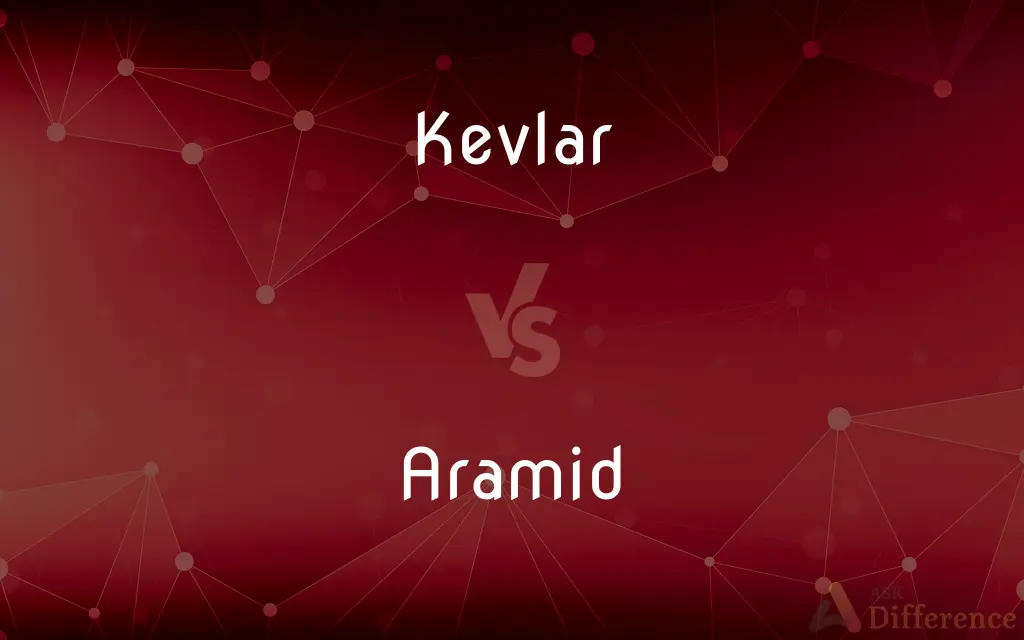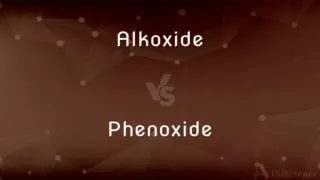Kevlar vs. Aramid — What's the Difference?
Edited by Tayyaba Rehman — By Urooj Arif — Updated on March 22, 2024
Kevlar is a well-known brand of aramid fiber known for its high strength and resistance to heat, whereas aramid refers to a class of synthetic fibers characterized by their strength and thermal stability.

Difference Between Kevlar and Aramid
Table of Contents
ADVERTISEMENT
Key Differences
Kevlar is a type of aramid fiber that has become synonymous with high-strength material used in bulletproof vests and other protective gear. It was developed by DuPont and is notable for its excellent tensile strength, durability, and resistance to heat. Aramid fibers, on the other hand, represent a broader category of heat-resistant and strong synthetic fibers, which include Kevlar among other types like Nomex, also developed by DuPont, primarily used for its fire-resistant properties.
While Kevlar is specifically designed for applications requiring high tensile strength and thermal stability, aramid fibers, in general, are utilized in a wide range of applications beyond protective clothing. These applications include aerospace components, automotive parts, electrical insulation, and ropes and cables. Kevlar's unique properties make it particularly suitable for products where protection and durability are paramount.
The manufacturing process of Kevlar involves the polymerization of an aromatic polyamide, which results in long molecular chains. This process gives Kevlar its exceptional strength-to-weight ratio. Aramid fibers, while also made from aromatic polyamides, can have different molecular structures and processing techniques, leading to a variety of properties suited to different applications.
In terms of market presence, Kevlar is a trademarked product known for its specific use in protective gear and has become a household name in that sector. Aramid fibers encompass a broader range of materials not limited to any single brand or application, offering versatility in their use across various industries.
Despite the differences in application and branding, both Kevlar and aramid fibers share a common foundation in their chemical structure and outstanding properties. They are both celebrated for their strength, durability, and ability to withstand extreme conditions, making them invaluable in industries where safety and performance are critical.
ADVERTISEMENT
Comparison Chart
Definition
A brand of aramid fiber known for its high strength and thermal resistance.
A class of synthetic fibers characterized by strength and thermal stability.
Applications
Bulletproof vests, protective clothing, ropes, and sporting goods.
Aerospace, automotive, electrical insulation, and protective clothing.
Properties
High tensile strength, durability, heat resistance.
Strength, thermal stability, varying degrees of heat resistance.
Manufacturing Process
Polymerization of aromatic polyamide with a specific process for strength.
Similar polymerization but varies to produce fibers with different properties.
Market Presence
Specific, well-known brand for protective gear.
Broad, includes various brands and products beyond protective gear.
Compare with Definitions
Kevlar
Employed in ropes and cables for its tensile strength and reliability.
Kevlar ropes are used in rescue operations for their unbreakable nature.
Aramid
Includes materials like Kevlar and Nomex, each with unique properties.
Nomex aramid fiber is primarily used for its fire-retardant properties.
Kevlar
A high-strength synthetic fiber used in protective gear and equipment.
Kevlar vests provide protection against bullets and knife attacks.
Aramid
A category of synthetic fibers used for their strength and thermal stability.
Aramid fibers are essential in manufacturing heat-resistant clothing for firefighters.
Kevlar
Known for its use in bulletproof vests and military helmets.
The police officer's Kevlar helmet deflected the debris during the explosion.
Aramid
Employed in electrical insulation for its non-conductivity and heat resistance.
Aramid paper is used in transformers for its insulating properties.
Kevlar
Applied in automotive parts for its durability and heat resistance.
Kevlar brake pads offer superior performance and longevity.
Aramid
Found in automotive applications for tires, brake pads, and gaskets.
Aramid-reinforced tires resist punctures and maintain integrity at high speeds.
Kevlar
Utilized in high-performance sporting equipment for its lightweight strength.
Racing sails made of Kevlar withstand strong winds without tearing.
Aramid
Utilized in aerospace engineering for components that require lightweight and strong materials.
Aramid composites are used in the construction of aircraft bodies.
Kevlar
Kevlar (para-aramid) is a heat-resistant and strong synthetic fiber, related to other aramids such as Nomex and Technora. Developed by Stephanie Kwolek at DuPont in 1965, the high-strength material was first used commercially in the early 1970s as a replacement for steel in racing tires.
Aramid
Aramid fibers are a class of heat-resistant and strong synthetic fibers. They are used in aerospace and military applications, for ballistic-rated body armor fabric and ballistic composites, in marine cordage, marine hull reinforcement, and as an asbestos substitute.
Kevlar
(uncountable) (Fabric, cordage, etc made of) aramid fiber, an exceptionally strong, light, man-made fibre used to strengthen cables and sheet materials, e.g. in stab-resistant vests.
Aramid
Any of a class of strong, heat-resistant synthetic fibres, used in aerospace and military applications.
Kevlar
A piece of personal protective equipment made from Kevlar, such as a helmet or a vest.
Common Curiosities
What distinguishes Kevlar from other aramid fibers?
Kevlar is known for its exceptional tensile strength and thermal stability, making it ideal for protective gear, while other aramid fibers may have different properties tailored to various applications.
How are aramid fibers made?
Aramid fibers are synthesized through the polymerization of aromatic polyamides, forming long chains that give the fibers their strength and thermal stability.
Can Kevlar be used in everyday products?
Yes, Kevlar is used in everyday products like smartphones, sporting goods, and tires, providing durability and protection.
What makes Kevlar effective in bulletproof vests?
Kevlar's high tensile strength allows it to absorb and distribute the energy of a bullet, preventing penetration and protecting the wearer.
Can aramid fibers conduct electricity?
Aramid fibers are generally non-conductive, making them suitable for electrical insulation applications.
Is Kevlar the strongest material available?
While Kevlar is extremely strong, especially in terms of tensile strength, there are other materials like carbon nanotubes and graphene that are known for their superior strength in certain applications.
Are all aramid fibers the same?
No, aramid fibers can vary in their molecular structure and processing, resulting in different properties suitable for diverse applications.
Can Kevlar and other aramid fibers be recycled?
Recycling of Kevlar and aramid fibers is challenging due to their chemical stability, but efforts are underway to find effective recycling methods.
Why are aramid fibers used in aerospace?
Their lightweight, strength, and resistance to heat and impact make them ideal for aerospace components, reducing weight while maintaining safety and performance.
Are aramid fibers environmentally friendly?
The production and disposal of synthetic fibers, including aramids, pose environmental challenges, though their durability and long life can mitigate waste compared to less durable materials.
What are the limitations of using Kevlar?
While Kevlar offers high strength and thermal stability, it can degrade under ultraviolet light and requires careful handling during manufacturing.
How does the cost of Kevlar compare to other materials?
Kevlar tends to be more expensive than common materials due to its specialized production process, but its performance benefits justify the cost in many applications.
Is there any development in aramid technology?
Ongoing research in aramid technology focuses on enhancing fiber properties, expanding applications, and improving environmental sustainability.
Share Your Discovery

Previous Comparison
Ding vs. Ping
Next Comparison
Alkoxide vs. PhenoxideAuthor Spotlight
Written by
Urooj ArifUrooj is a skilled content writer at Ask Difference, known for her exceptional ability to simplify complex topics into engaging and informative content. With a passion for research and a flair for clear, concise writing, she consistently delivers articles that resonate with our diverse audience.
Edited by
Tayyaba RehmanTayyaba Rehman is a distinguished writer, currently serving as a primary contributor to askdifference.com. As a researcher in semantics and etymology, Tayyaba's passion for the complexity of languages and their distinctions has found a perfect home on the platform. Tayyaba delves into the intricacies of language, distinguishing between commonly confused words and phrases, thereby providing clarity for readers worldwide.














































